Argentina’s peso, at record lows in black market, stokes market jitters
2023.04.25 04:12

© Reuters. FILE PHOTO: Argentine one hundred peso bills are displayed in this picture illustration taken September 3, 2019. REUTERS/Agustin Marcarian/Illustration
NEW YORK (Reuters) – Argentina’s peso tumbled to a record low in the popular black market as an election build-up sows uncertainty and the economy shows strains beyond the country’s all-important grains exports, hit by a crippling drought.
The peso hit an all-time low of 460 per dollar on Monday in a black market that has flourished as the official foreign exchange market is under tight controls. That is down from 400 pesos per dollar just a week ago and compares to the official spot rate of around 220.
Monday’s 4.6% daily decline was the largest in nine months. The gap between the black and official rates of more than 107% is the widest since August last year.
The peso’s slump puts more pressure on Alberto Fernandez’s government to devalue the currency, also lifted by central bank intervention that in March alone amounted to more than $1 billion.
“Devaluation rumors have abounded in Argentina ever since Fernandez became president. Yet against what economic logic would suggest, it has not happened,” said Carlos de Sousa, EM debt strategist and portfolio manager at Vontobel Asset Management.
“I’d be very surprised if this government devalues the official exchange rate before the presidential election, but it’s probably one of the first things the next government will do.”
Fernandez said last week he will not run for re-election in October, which could give him cover to enact a very unpopular move that would exacerbate inflation, already running above 100% annualized.
STUCK IN NEUTRAL
Data on Monday showed monthly economic activity was flat in February even as it expanded 0.2% annualized, while last week the trade balance posted a surprise $1.1 billion deficit, further pressuring the currency.
“Despite activity edging up in January and holding steady in February, in our assessment the sharp slowdown in activity seen at the end of 2022 is set to continue,” said Goldman Sachs (NYSE:)’ Sergio Armella in a note to clients on Monday.
“A bad harvest, tight FX and import controls, and headwinds from the very high inflation and growing macroeconomic imbalances and distortions should keep real activity data weak through 2023.”
Economic activity is set to contract 2.3% this year, the worst performance among the G20 countries, with inflation seen ending the year above 100%, according to median estimates from economists polled earlier this month.
The weak data has further muddied the waters in Buenos Aires. As the peso has slumped, rumors have circulated about political pressure rising on economy minister Sergio Massa and central bank chief Miguel Pesce, forcing officials into denials and public shows of solidarity.
Argentina’s economy has struggled to build its dollar reserves as agriculture exports have dropped, to the point that the International Monetary Fund lowered an already low bar for reserves set as part of a $44 billion financing program.
JPMorgan (NYSE:) said on Friday Argentina also failed its IMF program primary fiscal target for end-March, and said the government will request a formal waiver from the Fund “but also likely a relaxation of the annual 1.9% of GDP primary deficit target for 2023 in the upcoming review”.
Talk of a peso devaluation came back to the fore, but the near term impact on already high inflation makes it political suicide ahead of presidential elections.
A devaluation “will come at the expense of pushing up inflation even further in the near-term, but is needed to restore external competitiveness and help Argentina run the current account surpluses it needs to rebuild its FX reserves,” said Kimberley Sperrfechter, Latin America economist at Capital Economics in a note.
It is clear, she wrote, that the peso “is fundamentally misaligned”.







